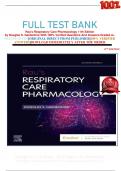FULL TEST BANK
Rau's Respiratory Care Pharmacology 11th Edition
by Douglas S. Gardenhire With 100% Verified Questions And Answers Graded A+
PRINTEND PDF|ORIGINAL DIRECT FROM PUBLISHER|100% VERIFIED
ANSWERS|DOWLOAD IMMEDIATELY AFTER THE ORDER
11TH EDITION
Complete Test Bank, All Chapter Are Included
For More Documents Search (Testbankproferssor.Stuvia)
,Contents
Chapter 01: Introduction To Respiratory Care Pharmacology Gardenhire: Rau’s Respiratory Care Pharmacology, 11th Edition .........2
chapter 02: principles of drug action ........................................................................................................................................................18
chapter 03: administration of aerosolized agents ......................................................................................................................................32
chapter 04: calculating drug doses ...........................................................................................................................................................49
chapter 05: central and peripheral nervous systems gardenhire: rau’s respiratory care pharmacology, 11th edition .............................57
chapter 06: adrenergic (sympathomimetic) bronchodilators gardenhire: rau’s respiratory care pharmacology, 11th edition ................71
chapter 7: anticholinergic (parasympatholytic) bronchodilators test bank...............................................................................................89
chapter 08: xanthines gardenhire: rau’s respiratory care pharmacology, 11th edition ............................................................................97
chapter 09: mucus-controlling drug therapy...........................................................................................................................................106
chapter 10: surfactant agents gardenhire: rau’s respiratory care pharmacology, 11th edition ..............................................................121
chapter 11: corticosteroids in respiratory care ........................................................................................................................................130
chapter 12: nonsteroidal antiasthma agents ............................................................................................................................................148
chapter 13: aerosolized antiinfective agents............................................................................................................................................157
chapter 14: antimicrobial agents gardenhire: rau’s respiratory care pharmacology, 11th edition .........................................................168
chapter 15: cold and cough agents gardenhire: rau’s respiratory care pharmacology, 11th edition......................................................180
chapter 16: selected agents of pulmonary value .....................................................................................................................................191
chapter 17: neonatal and pediatric aerosolized drug therapy gardenhire: rau’s respiratory care pharmacology, 11th edition..............202
chapter 18: skeletal muscle relaxants (neuromuscular blocking agents) gardenhire: rau’s respiratory care pharmacology, 11th edition
...............................................................................................................................................................................................................208
chapter 19: diuretic agents gardenhire: rau’s respiratory care pharmacology, 11th edition ..................................................................219
chapter 20: drugs affecting the central nervous system gardenhire: rau’s respiratory care pharmacology, 11th edition ......................227
chapter 21: vasopressors, inotropes, and antiarrhythmic agents gardenhire: rau’s respiratory care pharmacology, 11th edition ..........238
chapter 22: drugs affecting circulation: antihypertensives, antianginals, antithrombotics......................................................................250
chapter 23: sleep and sleep pharmacology .............................................................................................................................................263
Chapter 01: Introduction To Respiratory Care Pharmacology
Gardenhire: Rau’s Respiratory Care Pharmacology, 11th Edition
Multiple Choice
1. The Listing Of A Drug And The Amount Of Drug Are Found In Which Part Of A Prescription?
a. Superscription
b. Inscription
c. Subscription
d. Transcription (Signature)
Ans: B
The Superscription Directs The Pharmacist To Take The Drug Listed And Prepare The Medication; The
Inscription Lists The Name And Quantity Of The Drug Being Prescribed; The Subscription Provides
Directions To The Pharmacist For Preparing The Medication; And The Transcription, Or Signature, Is The
Information The Pharmacist Writes On The Label As Instructions To The Patient.
Ref: P. 7
2. If Generic Substitution Is Permitted On A Prescription:
,a. Drug From Only One Manufacturer Must Be Given.
b. Drug Formulation May Be Changed By The Pharmacist.
c. Any Manufactured Brand Of The Drug Listed May Be Given.
d. Drug Strength May Be Changed By The Pharmacist.
Ans: C
A Generic Substitution Allows Any Brand Of A Drug To Be Given, But The Pharmacist May Not Change A
Drug Formulation Without Specific Permission From The Prescribing Physician. A Physician Can Indicate To
The Pharmacist That Generic Substitution Is Permitted In The Filling Of The Prescription. In Such A Case, The
Pharmacist May Provide Any Manufacturer’s Version Of The Prescribed Drug, Rather Than A Specific Brand.
However, The Pharmacist May Not Change The Strength Of A Drug Without Specific Permission From The
Prescribing Physician.
Ref: P. 8
3. The Study Of Drugs, Including Their Origin, Properties, And Interactions With Living Organisms, Is Known As
a. Pharmacogenetics.
b. Pharmacology.
c. Therapeutics.
d. Toxicology.
Ans: B
Pharmacogenetics Is The Study Of The Interrelationship Of Genetic Differences And Drug Effects.
Pharmacology Is The Study Of Drugs (Chemicals), Including Their Origin, Properties, And Interactions With
Living Organisms.
Therapeutics Is The Art Of Treating Disease With Drugs. Toxicology Is The Study Of Toxic Substances And Their
Pharmacologic Actions, Including Antidotes And Poison Control.
Ref: P. 3
4. The Brand Name Given To A Drug By A Particular Manufacturer Is Known As The Drug’s
a. Chemical Name.
b. Generic Name. C. Official Name. D. Trade Name.
Ans: D
The Chemical Name Indicates The Drug’s Chemical Structure. The Generic Name Is Assigned By The United
States Adopted Name Council And Is Usually Based Loosely On The Drug’s Chemical Structure. The Official
Name Is The
, Name Given To The Generic Name Once A Drug Becomes Fully Approved For General Use And Is Admitted
To The United States Pharmacopeia–National Formulary. The Trade Name Is The Brand, Or Proprietary, Name
Given By A Particular Manufacturer. For Example, The Generic Drug Albuterol Is Currently Marketed By
Schering-Plough As Proventil® And By Glaxosmithkline As Ventolin®.
Ref: P. 5
5. To Find Official Information About Drugs (According To The Fda), You Need To Go To The
a. Physician’s Desk Reference (Pdr).
b. Basic & Clinical Pharmacology.
c. United States Pharmacopeia–National Formulary (Usp-Nf).
d. Goodman & Gilman’s The Pharmacological Basis Of Therapeutics.
Ans: C
Because The Pdr Is Prepared By Drug Manufacturers Themselves, It May Be Lacking In Objectivity. Basic &
Clinical Pharmacology Covers Only General Pharmacologic Principles And Drug Classes. Goodman &
Gilman’s The Pharmacological Basis Of Therapeutics Covers Only General Pharmacologic Principles And
Drug Classes. The Usp-Nf Is A Book Of Standards Containing Information About Medications, Dietary
Supplements, And Medical Devices. The U.S. Food And Drug Administration (Fda) Considers This Book The
Official Standard For Drugs Marketed In The United States.
Ref: P. 5
. 1




